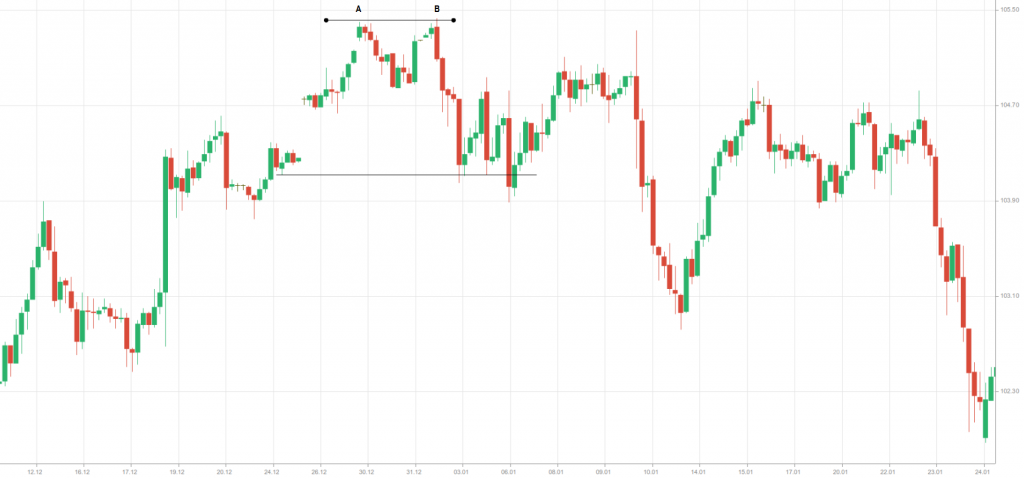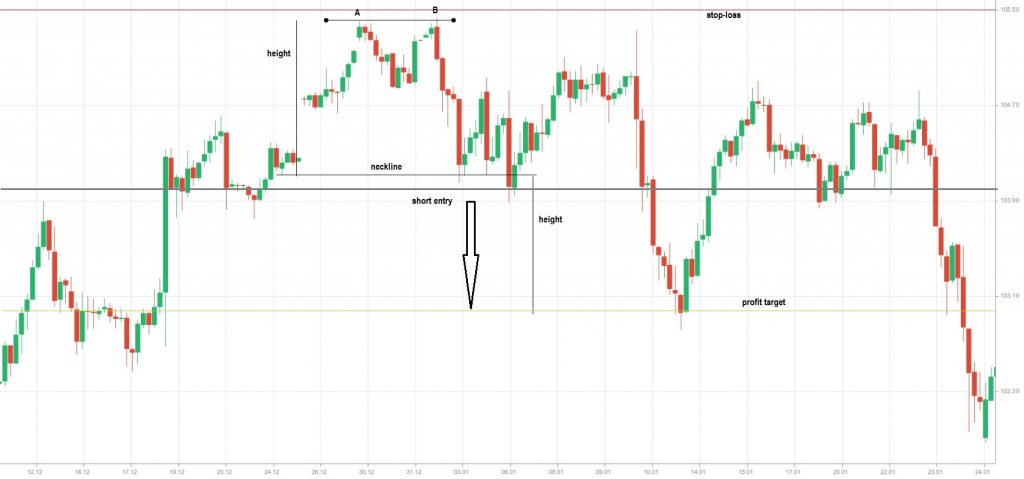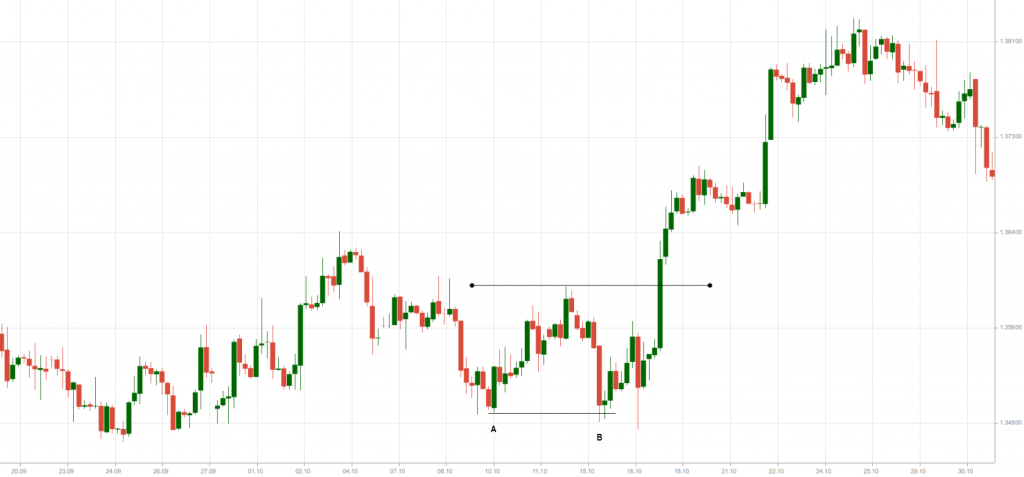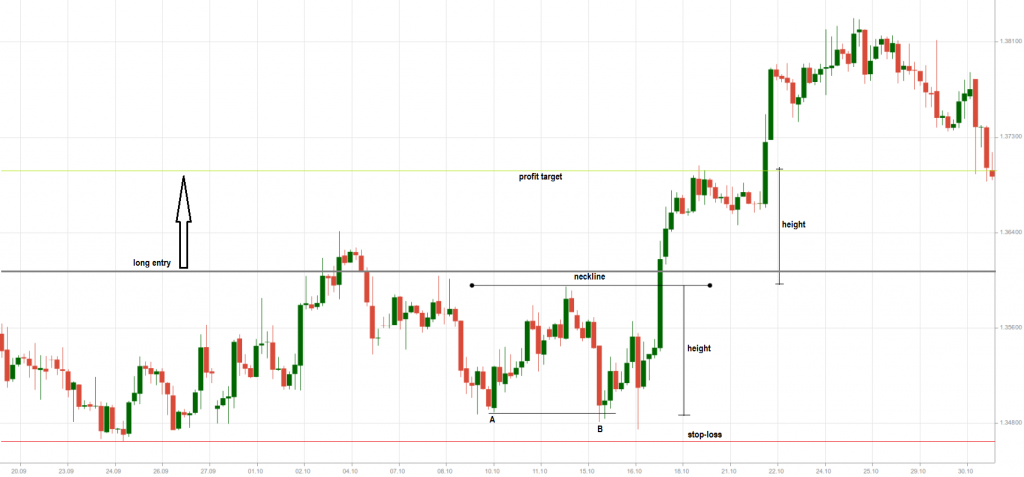Double Top and Double Bottom formations
This lesson will cover the following
- What is a Double Top?
- How to trade a Double Top?
- What is a Double Bottom?
- How to trade a Double Bottom?
These formations both represent trend reversal opportunities.
Double Top
The Double Top formation, also known as a ”M-shape” pattern, is bearish in nature. It usually forms after prices have been in an uptrend, thus, providing traders with the opportunity to sell.
On the 4-hour chart of USD/JPY above we can see that price action has reached two peaks, which are separated by a bottom. A so called ”neckline” can also be observed, which represents the bottom part of the formation.
For a pattern to be a real Double Top, the initial price needs to enter this formation from below the price level of the bottom (trough), while the exit needs to be on the breakout below the low price of the trough. Or, the neckline needs to be broken.
The two peaks need to be identical or within 5 percent of each others price level. The second peak may appear to be slightly higher than the first at times.
The retracement down after the first peak is preferable to show the same number of candles as the move to the second peak, but however, it is not 100% necessary.
The pattern is usually confirmed, when price action demonstrates a close below the low price of the bottom.
The pattern usually fails, when price action demonstrates a close above the second peak.
This pattern may form over two to seven weeks. The longer the period, however, the less reliable it becomes. Patterns, which show the best performance, usually include rounded peaks.
Let us look back at the chart and explain what may have happened. Long-positioned traders may have tried to breach a resistance level (as shown at A), but failed, because of short-positioned players moving in. Then, another attempt has been made by the long-positioned traders, but it failed to push prices to fresh highs, because a massive selling pressure has been encountered once again (as shown at B). It may have become evident that buyers will not be able to breach this strong resistance level, thus, prices took a turn downwards, with more sellers opening positions.
How to trade a Double Top?
A common way to trade a Double Top formation is to spot its ”neckline”. In case the price breaches it, traders may enter into a short position. A protective stop may be placed above the two peaks. If the pattern fails (prices continue to move above the second peak), losses will be limited.
In order to estimate the profit target, traders may take the height of the actual formation (the distance between the neckline and the highest of the two peaks) and place it down from the neckline. The 4-hour chart of USD/JPY below visualizes our short entry, our protective stop and our profit target when trading a Double Top.
Double Bottom
The Double Bottom formation, also known as a ”W-shape” pattern, is bullish in nature. It usually forms after prices have been in a decreasing trend, thus, providing traders with the opportunity to buy.
On the 4-hour chart of EUR/USD above we can see that price action has reached two bottoms (troughs), which are separated by a peak. A neckline can again be observed, which represents the upper (top) part of the formation.
For a pattern to be a real Double Bottom, the initial price needs to enter this formation from above the price level of the peak, while the exit needs to be on the breakout above the high price of the peak. Or, again the neckline needs to be breached.
The two bottoms need to be identical or within 5 percent of each others price level. The second bottom may appear to be slightly lower than the first at times.
The retracement up after the first bottom is preferable to show the same number of candles as the move to the second bottom, but however, it is not 100% necessary.
The pattern is usually confirmed, when price action demonstrates a close above the high price of the peak.
The pattern usually fails, when price action demonstrates a close below the second bottom.
The longer the period of formation, the less reliable this pattern becomes. Formations, which show the best performance, usually include rounded bottoms.
Let us look back at the chart. Long-positioned traders may have entered into trades at a support level and have obstructed the attempt by short-positioned traders to force the price down to even lower levels (as shown at A). Another attempt has been made by the short-positioned players to achieve this, but it failed, because a strong support has been encountered once again (as shown at B). It may have become evident that sellers will not be able to breach this solid support level, thus, prices took a turn upwards, with more buyers opening positions.
How to trade a Double Bottom?
A common way to trade a Double Bottom formation is to spot its ”neckline”. In case the price breaches it, traders may enter into a long position. A protective stop may be placed below the two bottoms. If the pattern fails (prices continue to move below the second bottom), losses will be limited.
In order to estimate the profit target, traders may take the height of the actual formation (the distance between the neckline and the lowest of the two bottoms) and place it up from the neckline. The 4-hour chart of EUR/USD below visualizes our long entry, our protective stop and our profit target when trading a Double Bottom.



